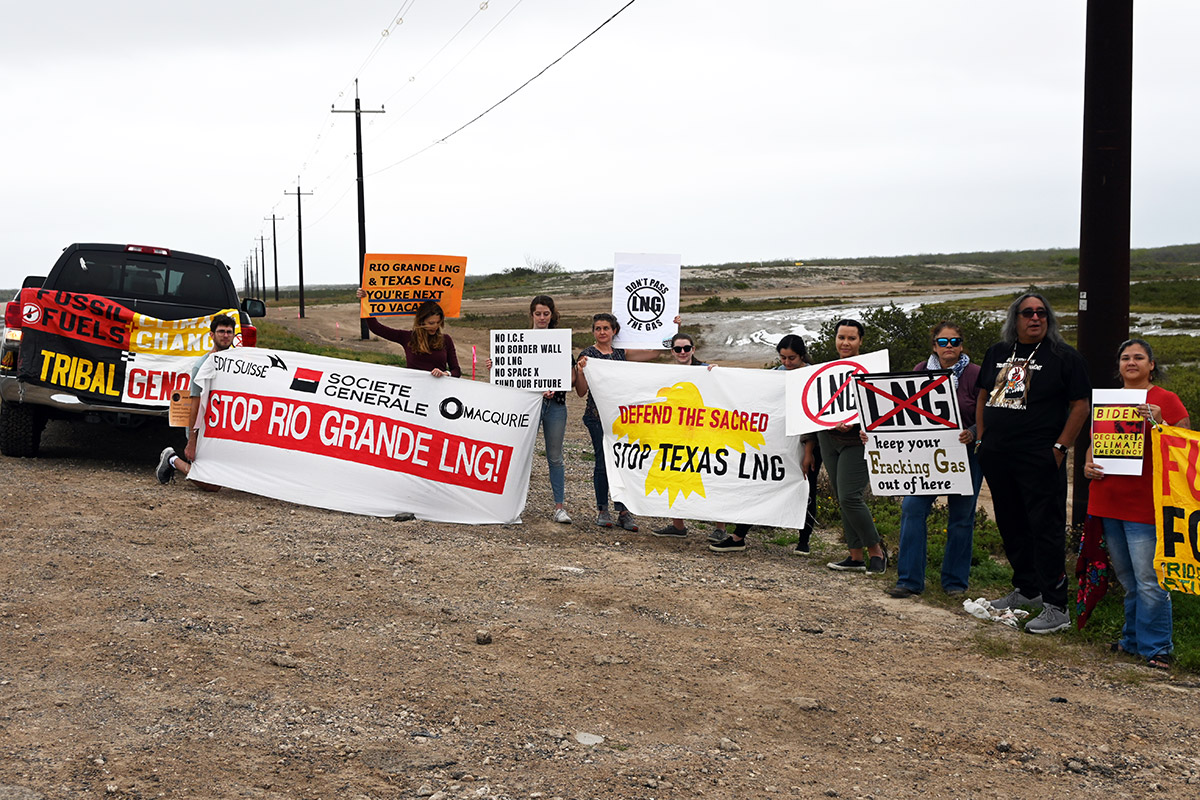I joined a delegation of women who are on the frontlines of fighting fracking and liquefied methane gas (LNG) in Texas, where we toured European countries with ties to this deadly fossil fuel industry. Methane gas is fracked in the Permian Basin and transported by pipeline to port communities like Corpus Christi, Port Arthur, or the Rio Grande Valley of Texas. The gas is then cooled to a liquid form, stored in colossal tanker ships, and shipped worldwide to countries like Germany, Spain, and Portugal. My community, the Rio Grande Valley, has opposed the Texas LNG, Rio Grande LNG, and the associated Rio Bravo Pipeline projects proposed for nearly a decade.
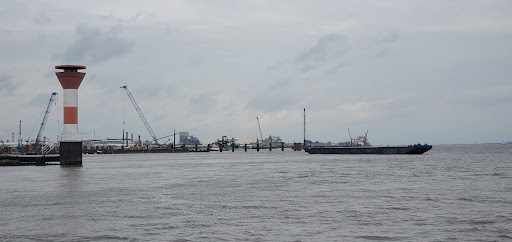
European Communities Facing LNG Import Terminals
Once the gas is liquefied, it’s transported via tanker ships across the Atlantic to LNG import terminal facilities. The tanker ships dock at the LNG import terminal site, and the liquefied gas is put into storage tanks to be processed back into a gas for electricity. Many European countries have built LNG import terminals or have plans to build new ones, like Germany, which has five planned LNG terminal sites. Construction and operation of these LNG facilities are highly destructive to the pristine lands the facilities are built on; industrialization impacts the surrounding community with explosion risks, and the emissions would damage the public’s health.
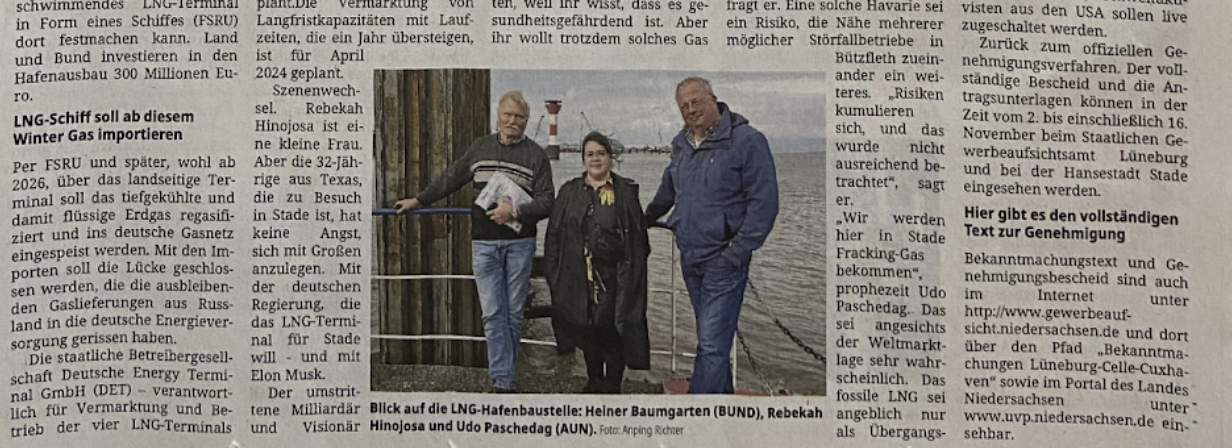
Port of Stade, Germany
We visited and met with several German community organizations impacted by existing and proposed LNG import terminals; these communities refuse to be used by the German government and fossil fuel corporations for the build-out of the fracking cycle. We toured the Stade community to see a proposed site of an LNG import terminal that plans to receive gas from the US Gulf Coast; activists here pointed at the open water in their ship channel where a company would dock an LNG ship.
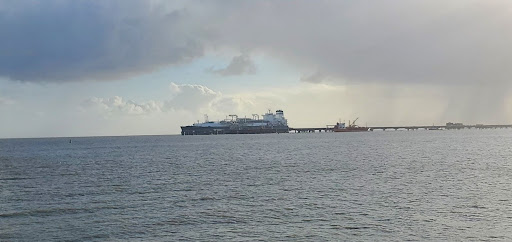
Wilhelmshaven, Germany
In Wilhelmshaven, we stood without proper coats with German activists in the windy, cold weather with intermittent hail falling on us at the port where a floating LNG terminal docked. Reporters listened to us as we explained what life is like for our communities in Texas dealing with LNG export terminals and dangerous fracking that feeds import terminals like the floating one in Wilhelmshaven.
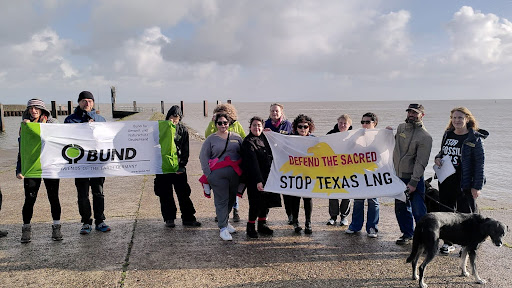
What we’re facing in Texas
In Texas, fracking sites can be seen next to daycares and in low-income communities of color where there’s little to no access to healthcare. I shared my personal story of attending a university in a North Texas town with fracking on campus, next to the football stadium, and the drill underneath the school. During my college life, we saw video footage of cancer-causing emissions from the drilling site billowing into the dorms, which was painful to watch, especially knowing that we were facing compounding student loan debt. The citizens of Denton, TX, voted to ban fracking in 2014, and the State of Texas immediately responded by passing a ban on fracking bans. While most European countries have banned fracking, the fossil fuel industry’s influence on the Texas government ensured that right was taken away from us—yet another hypocrisy we highlighted during the tour.
Chloe Torres, an organizer with Texas Campaign for the Environment, spoke to reporters about living near the Corpus Christi LNG export terminal in the Coastal Bend region of Texas, which actively sends tanker ships of liquid gas to this floating terminal. Chloe talked about “enormous flares, huge balls of fire,” and people mistaking the torches for the sunset.
Berlin, Germany
In Berlin, we joined a panel about communities facing LNG. We heard from German activists from Ruegen Island fighting a proposed LNG import terminal that could ultimately take over and devastate the island. It’s similar to the story of Quintana Island in Texas, which was turned into an industrial zone by the Freeport LNG export terminal. Freeport LNG eventually exploded last year because the company cut corners, such as not hiring enough staff; the blast resulted in a community member falling and splitting their head open. Melanie Oldham with Better Brazoria shared this story during the panel. Freeport LNG’s explosion forced a temporary shutdown, causing domestic gas prices to go down and back up again when the facility restarted. Activists from Ruegen gave each of us tokens from their island to take with us; mine was sanded beach wood with a piece of amber.
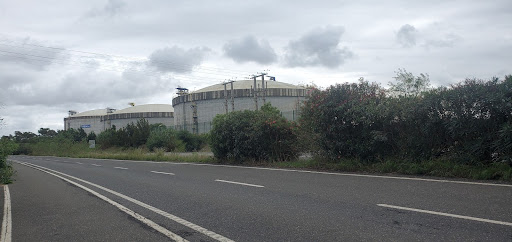
Sines, Portugal
I ventured off on my own and took several trains and buses (I missed a bus twice because of the language barrier) to Sines, Portugal, a beach town and the most industrial city in Portugal. I walked 45 minutes along the Port of Sines to the front gate of the LNG import terminal owned by the Portuguese company GALP, which plans to import gas from the not-yet-built Rio Grande LNG export facility proposed for my community. Portuguese activists had sat with me the day before in a Chinese restaurant in Lisbon to tell me the story of community members who did everything they could to stop the LNG import facility.
- Fisherman of Sines lined up their boats in the Port to show their opposition to LNG before it was built.
- Earlier this year, Portuguese activists with Climaximopt blocked the entrance of the LNG terminal, and other activists turned off the facility’s gas valves.
- With Friday’s for Future, Portuguese youth organizers tossed green paint at the Prime Minister of Portugal while they disrupted his speech and called him out for partnering with GALP.
- Years ago, a community organizer warned us that the company behind Rio Grande LNG had visited the U.S. consulate office in Lisbon to peddle the gas to their country. We’ve stayed in contact ever since then.
I left Portugal knowing our community is building a relationship with Portuguese activists.
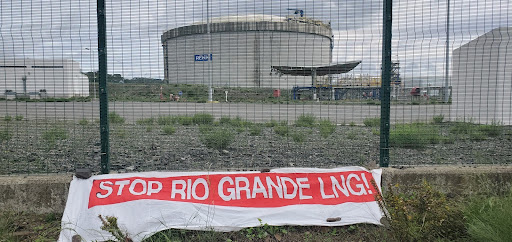
Every community I visited resisting an LNG import terminal had a similar story: their governments were working hand in hand with the fossil fuel industry to parrot falsehoods about the demand for LNG in Europe. Communities impacted by LNG in Germany and Portugal don’t need or want the gas; they won’t freeze in winter without it, and Europe is already oversupplied. Everyone we talked to agreed that this is being forced on us by corporations demanding profits.
European Banks are financing LNG and fracking in the Gulf South
The fracking cycle includes the process of drilling, pipelines, LNG import and export, and the corporations cutting the checks to the corporations building out this industry. European governments, corporations, and banks are directly involved in every part of the deadly fracking cycle in Texas. In Madrid, we joined a toxic tour with Spanish activists, where we went outside various corporate offices with banners and signs, and in particular to our fight, outside the office of the bank Banco Santander, which is directly financing Rio Grande LNG. In July of this year, Banco Santander gave a $1.08 billion loan to Rio Grande LNG.
Banco Santander is just one of the dozens of European investors jumping on the Rio Grande LNG project investment bandwagon. The other European investors include TotalEnergies (France), Intesa Sanpaolo (Italy), Standard Chartered Bank (UK), and HSBC (UK).
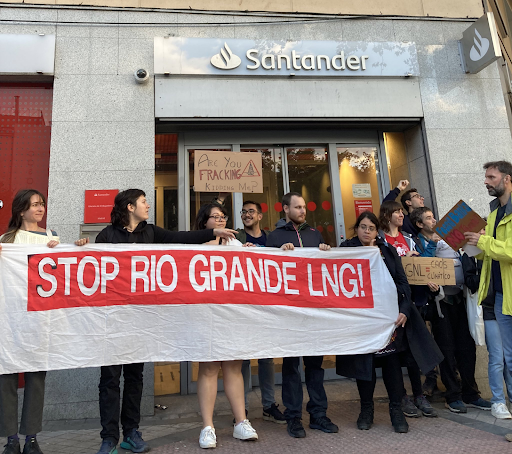
What’s at stake with Rio Grande LNG
Rio Grande LNG, the Rio Bravo Pipeline that would feed gas to this project, and the nearby Texas LNG project have yet to be built. Our community opposes these projects, and local organizations have lawsuits against the Federal Energy Regulatory Commission that rubber-stamped authorization. It’s not a done deal, and these LNG projects are still missing additional authorizations or permits to pour concrete on the pristine lands. The Rio Grande Valley: At Risk From Fracked Gas Terminals 2023 Summary Update details the status of the projects that inform investors to pull their money out and stay away.
We’re stepping up our opposition as these LNG companies begin prematurely staging their construction equipment in our community. The Carrizo Comecrudo Tribe of Texas, who are the original Indigenous people of the Rio Grande Valley, have land along the route of the Rio Bravo Pipeline, where they are showing their opposition to LNG. The Tribe is against their sacred lands, becoming part of a fossil fuel extraction colony for European governments, corporations, and banks. Our low-income Latine and Indigenous communities refuse to see our wetlands, sacred lands, and neighborhoods turned into a 3,000-acre complex of fossil fuel industrial landscape with smoking flares, storage tanks, and pollution.
